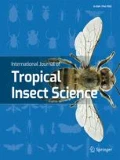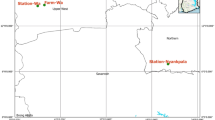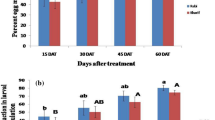Abstract
The introduction of fall armyworm (FAW), Spodoptera frugiperda (Lepidoptera: Noctuidae) into Ghana is a threat to maize production. This study determined the severity of this pest on maize production subjected to Bacillus thuringiensis (Bt), emamectin benzoate (Eb) sprayed and unsprayed farms under farmers’ practices in Ghana. At least one farm per treatment was selected in each Agro-Ecological Zone (AEZ) for data collection throughout the maize phenology during three production seasons. Percent damaged plants and ears were determined, the proportion of feeding damage on leaves and ears was scored, and yields measured on each farm. Ear damage was most severe in the Guinea Savannah Agroecological Zone with a correspondingly lower yield. The highest yield was recorded from the Tropical Rain Forest zone. The damage levels decreased when plants aged, but the scoring of damage level on attacked ears was greater than that on leaves. Maize plant damage was highest with corresponding lowest yields on unsprayed farms compared to sprayed farms which recorded similar results for both insecticides. Bt and Eb based insecticides (applied at 50g/15L H2O/ha and 75mL H2O/ha, respectively) are effective on FAW larvae and are therefore recommended for FAW management in Ghana.

Similar content being viewed by others
References
Abrahams P, BatemanM, Beale T, Clotte V, Cock M et al (2017) Fall armyworm: impacts and implications for Africa. CABI Evidence Note (2), September 2017. Report to DFID. https://www.invasive-species.org/Uploads/InvasiveSpecies/Fall%20Armyworm%20Evidence%20Note%20September%202017.pdf (accessed 13 August 2018)
Adamczyk JJ Jr, Adams LC, Hardee DD (2001) Field efficacy and seasonal expression profiles for terminal leaves of single and double Bacillus thuringiensis toxin cotton genotypes. J Econ Entomol 94:1589–1593
Agboyi LK, Goergen G, Beseh P, Mensah SA, Clottey VA, Glikpo R, Buddie A, Cafá G, Offord L, Day R, Rwomushana I, Kenis M (2020) Parasitoid complex of fall armyworm, Spodoptera frugiperda, in Ghana and Benin. Insects 11:68. https://doi.org/10.3390/insects11020068
Ali A, Luttrell RG, Pitre HN, Davis FM (1989) Distribution of fall armyworm (Lepidoptera: Noctuidae) egg masses on cotton. Environ Entomol 18:881–885
Ali A, Luttrell RG, Pitre HN (1990) Feeding sites and distribution of fall armyworm (Lepidoptera: Noctuidae) larvae on cotton. Environ Entomol 19:1060–1067
Ashley TR (1979) Classification and distribution of fall armyworm parasites. Fla Entomol 62:114–122
Bass MH (1978) Fall armyworm: Evaluation of insecticides for control. Auburn Univ Agric Exp Stn Leaflet 93:7
Beuzelin J, Brown S, Davis J, Foil LD, Hall M, Huang F, Kerns D, Morgan A, Pollet D, Reed D et al (2014) Cotton insect pest management, p. 7– 12. In 2014 Louisiana Insect Pest Management Guide. LSU Ag Center [Online] (http://www.lsuagcenter.com/NR/rdonlyres/B733BE31-7DEA-4264-93A6-AF6FED7023D3/96796/pub1802InsectMgmtGuide2014completebook247pages.pdf) (accessed 15 Sep 2014)
Capinera J L (2000) Fall armyworm, Spodoptera frugiperda (J.E. Smith) (Insecta: Lepidoptera: Noctuidae). The University of Florida, Institute of Food and Agricultural Sciences. (UF/IFAS), Gainesville, FL
Capinera JL (2017) Fall Armyworm, Spodoptera frugiperda (J.E. Smith) (Insecta: Lepidoptera: Noctuidae). Available online: http://edis.ifas.ufl.edu/in255 (accessed on 10 Oct 2017)
Carvalho RPL (1970) Danos, Ilutuação de população, controle e comportamento de Spodoptera frugiperda (J.E. Smith, 1794) susceptibilidade de dilerentes genótipos de milho em condições de campo. (Piraci aba: Imprensa ESALQ) PhD Thesis, pp 170
Casmuz A, Juárez ML, Socias MG, Murúa MG, Prieto S, Medina S, Willink E, Gastaminza G (2010) Revisión de los hospederos del gusano cogollero del maíz, Spodoptera frugiperda (Lepidoptera: Noctuidae). Rev Soc Entomol Arg 69:209–231
Cock MJW, Beseh PK, Buddie AG, Cafá G, Crozier J (2017) Molecular methods to detect Spodoptera frugiperda in Ghana, and implications for monitoring the spread of invasive species in developing countries. Sci Rep 7:4103. https://doi.org/10.1038/s41598-017-04238-y
Cruz I (1995) A lagarta-do-cartucho na cultura do milho. Embrapa/CNPMS. Circ Téc 21:45
Cruz I, Oliveira LJ, Oliveira AC, Vasconcelos CA (1996) Eleito do nível de saturação de alumínio em solo ácido sobre os danos de Spodoptera frugiperda (J. E. Smith) em milho. An Soc Entomol Brasil 25:293–297
Cruz I, Turpin FT (1982) Eleito da Spodoptera frugiperda em dilerentes estágios de crescimento da cultura de milho. Pesqui Agropecu Bras 17:355–359
Cruz I, Turpin FT (1983) Yield impact of larval infestation of the fall armyworm Spodoptera frugiperda (J. E. Smith) to mid-whorl growth stage of corn. J Econ Entomol 76:1052–1054
De Almeida Sarmento R, de Souza Aguiar RW, Vieira SMJ, de Oliveira HG, Holtz AM (2002) Biology review, occurrence and control of Spodoptera frugiperda (Lepidoptera, Noctuidae) in corn in Brazil. Biosci J 18:41–48
Food And Agriculture Organization (FAO) (2019) FAO Statement on Fall Armyworm in Sri Lanka. Rome, Italy: FAO. http://www.fao.org/srilanka/news/detail-events/en/c/1177796/. Accessed 29 Aug 2020
Goergen G, Kumar PL, Sankung SB, Togola A, Tamò M (2016) First report of outbreaks of the fall armyworm Spodoptera frugiperda (J.E. Smith) (Lepidoptera, Noctuidae), a new alien invasive pest in West and Central Africa. PLoS One 11(10):e0165632. https://doi.org/10.1371/journal.pone.0165632
Gómez-Valderrama EJ, Guevara-Agudelo EJ, Barrera-Cubillos GP, Cotes-Prado AM, Villamizar-Rivero LF (2010) Aislamiento, identificación y caracterización de Nucleopoliedrovirus nativos de Spodoptera frugiperda en Colombia. Rev Fac Nac Agron Medellín 63(2):55115520
Hernández-Mendoza JL, López-Barbosa EC, Garza-González E, Pérez MN (2008) Spatial distribution of Spodoptera frugiperda (Lepidoptera: Noctuidae) in maize landraces grown in Colima. México. Int J Trop Ins Sci 28:126–129
Indian Council of Agricultural Research, National Bureau of Agricultural Insect Resources (ICAR-NBAIR) (2018) Spodoptera frugiperda (J. E. Smith). Insects in Indian Agrosystems. ICAR-National Bureau of Agricultural Insect Resources (NBAIR), India. http://www.nbair.res.in/insectpests/Spodoptera_frugiperda.php
International Institute of Tropical Agriculture (IITA) (2018) Fall armyworm has reached the Indian subcontinent! Ibadan, Nigeria: IITA. http://www.iita.org/news-item/fall-armyworm-has-reached-the-indian-subcontinent
International Plant Protection Convention (IPPC) (2018) First detection of Fall Army Worm on the border of Thailand. IPPC Official Pest Report, No. THA-03/1. FAO: Rome, Italy. https://www.ippc.int
International Plant Protection Convention (IPPC) (2019) First Detection Report of the Fall Armyworm Spodoptera frugiperda (Lepidoptra: Noctuidae) on Maize in Myanmar. IPPC Official Pest Report, No. MMR-19/2. Rome, Italy: FAO. https://www.ippc.int
Koffi, D, Agboka K, Adenka KD, Osae M, Tounou AK, Adjevi MKA, Fening KO, Meagher Jr RL (2020a) Maize infestation of fall armyworm (Lepidoptera: Noctuidae) within agro-ecological zones of Togo and Ghana in West Africa 3 Yr after its invasion. Environ Entomol XX(XX):1–6. https://doi.org/10.1093/ee/nvaa048
Koffi, D, Kyrematen R, Eziah YV, Agboka K, Adom M, Goergen G, Meagher RL (2020b) Natural enemies of fall armyworm, Spodoptera frugiperda (J.E. Smith) (Lepidoptera: Noctuidae) in Ghana. Fla Entomol 103(1):85–90
Koffi D, Kyrematen R, Eziah YV, Osei-Mensah OY, Afreh-Nuamah K, Aboagye E, Osae M, Meagher RL (2020c) Assessment of impacts of fall armyworm, Spodoptera frugiperda (Lepidoptera: Noctuidae) on maize production in Ghana. J Integr Pest Mang 11(1):1–7. https://doi.org/10.1093/jipm/pmaa015
Luginbill P (1928) The fall armyworm. US Dept Agric Tech Bull 34(1–91):2
Ministry of Food and Agriculture (MoFA) (2016) Agriculture in Ghana. Statistics, Research and Information Directorate, Accra, Ghana, 4 pp.
Nagoshi RN, Meagher RL (2004) Seasonal distribution of fall armyworm (Lepidoptera: Noctuidae) hoststrains in agricultural and turf grass habitats. Environ Entomol 33:881–889
Nagoshi RN, Koffi D, Agboka K, Tounou KA, Banerjee R, Jurat-Fuentes JL et al (2017) Comparative molecular analyses of invasive fall armyworm in Togo reveal strong similarities to populations from the eastern United States and the Greater Antilles. PLoS One 12(7):e0181982
Nagoshi RN, Goergen G, Tounou KA, Agboka K, Koffi D, Meagher RL (2018) Analysis of strain distribution, migratory potential, and invasion history of fall armyworm populations in northern sub-Saharan Africa. Sci Rep 8:3710
Perdiguero JS, Barral JM, De Stacul M V (1967) Aspectos biologicos de plagas de maíz de la región chaqueña. Evaluatión de daño. INTA, Estación Experimental Agropecuaria
Pitre HN (1979) Fall armyworm on sorghum: other hosts. Bull. 876. Mississippi Agric For Exp Stn Mississippi State, MS
Pitre HN, Hogg DB (1983) Development of the fall armyworm on cotton, soybean and corn. J Georgia Entomol Soc 18:182–194
Pitre HN, Mulroony JE, Hogg DB (1983) Fall armyworm (Lepidoptera: Noctuidae) oviposition: crop preference and egg distribution on plants. J Econ Entomol 76:463–466
Sparks A (1979) A review of the biology of the fall armyworm. Fla Entomol 62:282–287
Sparks AN (1986) Fall armyworm (Lepidoptera: Noctuidae): Potential for area-wide management. Fla Entomol 69:603–614
Tinoco R, Halperin D (1998) Poverty, production and health: inhibition of erythrocyte cholinesterase through occupational exposure to organophosphate insecticides in Chiapas, México. Arch Enviro Health 53:29–35
Willlams WP, Davis FM (1990) Response 01 corn to artificial infestation with fall armyworm and southwestern corn borer larvae. Southwest Entomol 15:163–166
Willink E, Osores VM, Costilla MA (1991) EI gusano cogollero dei maiz. Avance Agroindustrial 3–7
Wiseman BR, Williams WP, Davis FM (1981) Fall armyworm: Resistance mechanisms in selected corns. J Eco Entomol 74:622–624
Wiseman BR, Davis FM, Williams WP (1983) Fall armyworm: Larval density and movement as an indication of non-preference in resistant corns. Prot Ecol 5:135–141
Wiseman BR, Davis FM (1990) Plant resistance to insects attacking corn and grain sorghum. Fla Entomol 73:446–458
Young JR (1979) Fall armyworm: control with insecticides. Fla Entomol 62:130–133
Yu SJ (1983) Age variation in insecticide susceptibility and detoxification capacity of fall armyworm (Lepidoptera:Noctuidae) larvae. J Econ Entomol 76:219–222
Author information
Authors and Affiliations
Corresponding author
Ethics declarations
Competing interest
Authors declare no competing interests.
Additional information
Publisher's Note
Springer Nature remains neutral with regard to jurisdictional claims in published maps and institutional affiliations.
Supplementary information
Below is the link to the electronic supplementary material.
Rights and permissions
About this article
Cite this article
Koffi, D., Kyerematen, R., Osae, M. et al. Assessment of Bacillus thuringiensis and emamectin benzoate on the fall armyworm Spodoptera frugiperda (J. E. Smith) (Lepidoptera: Noctuidae) severity on maize under farmers’ fields in Ghana. Int J Trop Insect Sci 42, 1619–1626 (2022). https://doi.org/10.1007/s42690-021-00683-5
Received:
Accepted:
Published:
Issue Date:
DOI: https://doi.org/10.1007/s42690-021-00683-5




